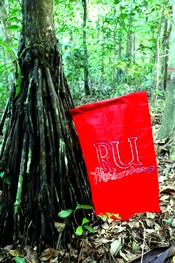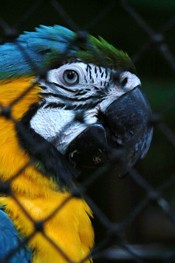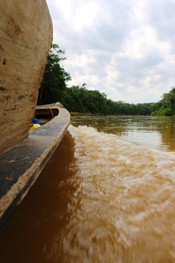Radford Amazonian Research Expedition assembling team

More than 30 students explored a unique Maymester 2015 opportunity to do meaningful, original scientific research on understanding and protecting the Amazon River and the rainforests at its headwaters.
Led by Assistant Professors of Biology Jason Davis and Joy Caughron, the first Radford Amazonian Research Expedition (RARE) began assembling its 12-person team with an information session Oct. 21 in Reed Hall.
The expedition's prospects were exciting to Sarah Hebert, a sophomore biology major from Powhatan. She wants to focus her individual research effort on the water environment and the Amazonian frogs and salamanders. Her thesis is that amphibians are often early indicators of human-caused environmental change. As the expedition assesses the effects of that change on the vast wilderness, she wants in.
"It is an opportunity to do field research and it will be my first opportunity. I am excited because of the doors it might open for me in the field and as a career opportunity," Hebert said.

Caughron said the expedition will be interdisciplinary and ideally include students from different majors. As examples of RARE's interdisciplinary applications, Caughron cited the potential to do research about culture and language to a foreign language or sociology major, the chance to assess native plants and healing regimens and jungle health for nursing majors and learning volunteer ecotourism to a recreation, parks and tourism major.
The team will leave May 17 and return June 7, 2015, and spend their time in the Madre de Dios River region that lies at the headwaters of the Amazon River at the Las Piedras Biodiversity Research Station. They will be under the guidance of Tamandua Expeditions, which focuses on biodiversity research, conservation and responsible volunteer/adventure travel.
The team will travel by jungle road and river to reach its location deep in the lowland tropical rainforest at the base of the Andean range, one of the most biologically diverse regions on earth. They will also visit and volunteer at the Tambopata Animal Rehabilitation Station and have been challenged to a friendly soccer match by residents of the nearby town of Lucerna, according to Davis.
At the session, Davis reviewed the mechanics of the expedition – research plans, pre-trip preparations, cost and requirements and funding options. He fielded questions about water quality for showers, bug bites, emergency protocols and the types of work that the team will do.
Among the team's research objectives are studies of vertebrates, invertebrates, botanical, microbial and human health in a rain forest environment that covers 2,700 acres of diverse forest habitat. The team will be equipped with field and laboratory equipment, such as wireless microscope cameras, solar power generators, sat-fi Internet connections, genetic sampling and preservation systems, infra-red trail cameras, GoPro cameras, forestry, soil and water testing gear and an abundance of curiosity.

"This is a chance to put your name on new discoveries in science in a really, really remote area that is changing rapidly," Davis said.
To apply for BIO 481: Special Topics in Biology: Radford Amazonian Research Expedition, visit the International Education Center website. Interested students should select Peru - Biology under Faculty-led programs (Summer 2015). The course will have a one-credit on-campus spring component and the study abroad component will carry two biology elective credits.
For more information, contact Davis at jdavis319@radford.edu or 831-5353.